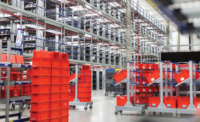When it comes to logistics and the ability to ship goods to market on time, snack and bakery producers face many challenges. Today’s consumers are health-conscious and looking to purchase fresh goods at a greater frequency. This affects how these goods are transported and delivered.
One of the biggest challenges is keeping up with constant adjustments to store delivery time windows. In a static or dynamic routing environment, time window changes for one customer affect several, if not all, customers on that route. Store managers often juggle time windows for their suppliers, so this is a constant challenge.
“Today, we see greater delivery frequencies with lower volumes per delivery,” says Al Pinto, vice president of dedicated transportation solutions, Ryder System Inc., Miami. “On some routes, we’ve increased the number of stops per week while delivering the same volume. This can lead to inefficiencies if you don’t know how to manage and consolidate your route plans.”
Fleet cost is a major factor in determining the cost base associated with distribution, according to Derek Curtis, vice president of sales, HighJump, Minneapolis. “With Amazon driving consumer expectations of immediate/convenient/free delivery, logistics challenges are growing. As a result, distribution channels are trending away from traditional or static routing toward a more dynamic routing approach.”
Advanced solutions
The good news is that a variety of software solutions are available. Location, visibility, analytics and alerting are combined to provide a better view of fleet resources, says Simon Bunegar, senior vice president of marketing, CX North America, Tecumseh, Ontario. “Organizations are now able to see where all their available resources are—and where they will be in the future—and, through analytics, understand how these resources can be better employed.”
Integrating in-cab vehicle tracking equipment with routing and scheduling software is part of that logistics trend. It allows snack and bakery companies to track the progress of their drivers. Users can see when a vehicle arrives at a delivery, how long it takes and when it departs. Should a delay arise, the customer service team can notify store managers in advance.
Ryder System uses handheld scanners to streamline the delivery process. “We often deliver from a plant to a depot where four or five local bakeries run routes, so someone may not be available to check in the products. The handheld scanners enable us to confirm delivery and authenticate the load. We also use GPS trailer tracking, which helps us manage tight delivery windows,” Pinto explains.
Lower-priced mobile technology has improved the accessibility of solutions for all fleet operations, according to Curtis. “One way to reduce costs is to show metrics regarding asset utilization and cost/profit per delivery. This process can help identify where delivery schedules need to be adjusted, or where additional surcharge logic is required to ensure that the product is delivered in a profitable manner.”
Route optimization continues to grow in sophistication and in adoption rates, Curtis adds. “One key trend is to focus less on the ‘perfect’ solution and more on the ‘simple’ solution. By requiring less effort to define complicated routing algorithm and logic, and permitting clients to deploy quickly and on budget, simplified solution deployments seem to be a trend taking hold.”
Delivery windows often overlap with periods of road congestion issues, says Will Salter, CEO and president, Paragon Software Systems, Frisco, TX. “With Paragon’s Route Control solution, companies can automate vehicle route planning for recurring, timed events. This is achieved by placing markers (waypoints) along the route to influence the selection or exclusion of roads. When the Paragon routing software reaches a waypoint, it looks at the parameters associated with it, and makes a decision about whether to continue on the usual route or divert away from potential issues.”
Paragon Software Systems’ Waypoint Mapping module ensures that drivers follow each waypoint in the transport plan by feeding information into a Sat Nav device in the delivery truck. At each decision-making point, the driver is guided by the Sat Nav to ensure that he or she follows the planned route.
The Mobile Enterprise Management (MEM) platform from Telogis, Aliso Viejo, CA, provides information on location, diagnostics and driver behavior. A broader platform encompasses truck-specific navigation, work order management, route optimization and mobile applications for estimated time of arrival (ETA).
“In addition to handling day-to-day routing requirements, the Telogis Route suite includes tools that help with strategic planning, territory mapping and appointment scheduling. In today’s logistics environment, these tools are critical for managing assets and resources,” says Ray Zujus, director, food and beverage business development.
Ryder System has developed RyderShare, a cloud-based platform that provides real-time visibility of a load, as well as updates, such as alerts. It is available on a desktop or a mobile app. “Ryder System Inc. relies on routing optimization technology to maximize cube and minimize mileage, which makes the increased frequency of stops more manageable,” Pinto says.
Optimizing vehicle operation
Delco Foods, Indianapolis, is installing electronic logging devices (ELDs) in all its trucks. This will allow managers to monitor (in real-time) factors such as driver location, speed, miles per gallon (MPG) and engine data. “We will utilize data captured from these devices to improve driver behavior related to MPG, shift patterns, quick acceleration and hard braking. The devices also will satisfy new logging regulations that will start being enforced in December 2017,” says Doug Deardorff, vice president of operations.
CX North America recently introduced Replay functionality. It allows users to review each delivery in its entirety and evaluate what happened in terms of milestones and events, either in real time or in a retrospective report. Replay has helped improve driver quality and efficiency across many organizations, Bunegar says.
All diesel trucks from Isuzu Commercial Truck of America Inc., Anaheim, CA, feature an Isuzu Health Report that allows fleet owners to see how their trucks are being operated. The report records engine, transmission, brake and emissions systems—comparing the brake usage and fuel economy history of all drivers. It also shows driver-operating habits such as acceleration and deceleration frequency and speed history, and can determine if the driver is performing diesel particulate fuel (DPF) regeneration.
Paragon Software Systems recently added a fuel usage enhancement to its routing and scheduling software. The ability to predict fuel usage levels by an individual route is now complemented by the ability to compare actual usage against what is expected. This provides greater understanding of where excessive consumption is occurring within a fleet and what action can be taken to help drivers reduce fuel costs and associated carbon emissions.
Telogis Coach is designed to improve the effectiveness of fleet safety programs by giving drivers the tools to monitor and manage unsafe driving habits. “Telogis Coach is a mobile gamification app that uses metrics to create a snapshot or leader board for drivers. The goal is to create friendly competition among teams to improve performance metrics,” Zujus says.
Delivery vehicle enhancements are improving the process, as well. One example is the introduction of Sprinter-type vehicles—delivery trucks usually built on a pickup truck chassis and featuring a high box—for use in high-density metro areas. The smaller wheelbase and length allows for greater maneuverability in dense areas, but the high box assures that the vehicle’s smaller footprint does not result in a loss of volume, according to Charles Dawson, marketing manager, TMW Systems, Cleveland.
With diesel prices staying low, Delco Foods has seen a slowdown of new companies adopting compressed natural gas (CNG). “However, those of us who are early adopters of the technology know the benefits and are committed to its use. The infrastructure is growing and allowing us to send our CNG trucks virtually anywhere in our delivery areas,” Deardorff says.
Dawson contends that the use of alternative fuels is not widespread because of the lack of refueling stations in rural areas. “Bakery/snack producers serve many direct store delivery (DSD) customers in remote areas; finding natural gas refueling stations in these areas can be difficult. However, there are opportunities to diversify fleets by adding alternative fuel vehicles for companies that have a presence in urban areas where refueling options are greater,” he says.











